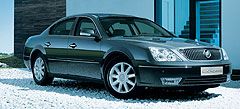Holden engine exports to China to quadruple
BY TERRY MARTIN | 14th Jul 2009

Federal industry minister Kim Carr delivered the news in Shanghai last weekend after holding talks with GM’s just-promoted vice-president of international operations Nick Reilly, along with GM China managing director (and former Holden executive) Kevin Wale and other senior executives from GM China and affiliates Shanghai Automotive and Wuling.
“We’ve seen part as a result of that conversation that engine exports from General Motors plants in Port Melbourne are likely to increase by 400 per cent over the next four years to move from a present 6000 volume through to 20,000 over a four-year period,” Senator Carr said.
“That one particular event demonstrates the opportunities there are here for the Australian automotive industry in the People’s Republic of China, its automotive industry, to be able to collaborate to improve its co-operation whether it be in light metals, whether it be in battery technologies, whether it be in fuel systems, whether it be in composite materials.

“Both the industries want to move towards a green future. We have the technology, we have the quality. We are one of the 15 countries in the world that can make a car from the very beginning to the showroom floor and we want to share that technology and work with the People’s Republic of China in ensuring that we are able to improve the operations of both our automotive industries.”GM Holden has confirmed that the engines Senator Carr was referring to were V6s from its High Feature V6 (HFV6) plant in Port Melbourne, which supplies engines for GM vehicles across the world, including the Holden Caprice-based Buick Park Avenue built in China.
“We anticipate an increase in V6 engine exports, particularly to the key Chinese market in coming years,” GM Holden corporate communications manager Jonathan Rose told GoAuto this week. “That’s obviously contingent on future model programs in China.
“It’s very pleasing to be recognised overseas for our technical capabilities and having Shanghai GM being enthusiastic about the opportunity with senior Australian government ministers.
“We very much appreciate the government’s support in promoting our expertise to important overseas markets. Once again, it demonstrates their commitment to an Australian automotive industry.
“We said at the time of the decision to end the Pontiac brand, that we would get back out there and find new export opportunities for our engines and vehicles around the world.
“We’re continuing to do just that.”GoAuto understands that Australia could become the long-term engine export hub for several premium GM vehicles in China.
In the current Buick range alone, the Enclave SUV uses the spark-ignition direct-injection (SIDI) HFV6 in 215kW/366Nm 3.6-litre guise, while the recently launched LaCrosse medium-sized sedan features it in 190kW/296Nm 3.0-litre form – a displacement that is also said to be slated for the Australian Commodore in the coming months.
China could follow North America’s lead in adding the 3.6 SIDI to the LaCrosse line-up, while booming Buick sales also bode well for the future of the V6-powered Park Avenue (2.8/3.6) and the GL8 people-mover (2.5/3.0).
Senator Carr has been in China with federal trade minister Simon Crean to conclude a free-trade agreement with the Asian powerhouse and to develop a stronger “co-operative relationship” in the automotive sector.
As well supporting new opportunities for Holden, the ministers have held talks with management from a number of other Chinese car manufacturers, including Geely, Chery, Dongfeng and JAC, and senior municipal and provincial leaders.
They have also attended a ceremony marking the 10,000th-seat-per-month milestone, in exports to China, for Australian components manufacturer Futuris.
Mr Crean said the Australian trade delegation would not only be meeting specifically with the automotive sector in areas in which Australia already has a presence in China, but “looking for greater opportunities given the strength of the automotive market here and the great potential strength the Australian automotive market has to develop a co-operative relationship with China”.
In a joint statement released last week, the ministers said China’s position as the world’s largest market for new passenger vehicles, and double-digit growth rates in the Anhui and Hubei provinces during the current economic downturn, had expanded opportunities for Australian industries.
“China is a key market for the future of Australia’s automotive industry,” Senator Carr said. “We will deliver the message that Australia has the auto design and engineering expertise – including new and green technologies – to allow Australia to play a lead role in the rapidly changing Chinese auto market.”Mr Crean added: “We want to drive greater levels of co-operation between the auto sectors in Australia and China and help Australian companies to secure a bigger slice of the action in the world’s largest new passenger car market.
“We are actively pursuing a second track of commercial links at the business-to-business and government-to-business level with China. We are keen to expand Australia’s commercial footprint across the breadth of China, including in areas of central and western China.”Despite earlier this month posting a $70.2 million operating loss for 2008, GM Holden chairman and managing director Mark Reuss declared in June that Holden would move back into profit in the first half of 2010 – if not before – with new export contracts making a significant contribution.
The Chinese engine export boost for Holden’s Fishermens Bend V6 plant follows a recent contract win against three other GM engine plants to send 2500 engines a month to Mexico for the Cadillac SRX.
Other export destinations for Holden-built V6 engines include South Korea, the Middle East, Europe and Africa.